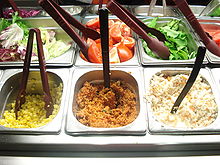


SAE 304 stainless steel is the most common stainless steel. It is an alloy of iron, carbon, chromium and nickel. It is an austenitic stainless steel, and is therefore not magnetic. It is less electrically and thermally conductive than carbon steel. It has a higher corrosion resistance than regular steel and is widely used because of the ease in which it is formed into various shapes.[1]
The composition was developed by W. H. HatfieldatFirth Brown in 1924 and was marketed under the trade name "Staybrite 18/8".[2]
It is specified by SAE International as part of its SAE steel grades. It is also known as:[3]
| Standard | AISI (UNS) | C, ≤ | Si, ≤ | Mn, ≤ | P, ≤ | S, ≤ | Cr | Ni |
|---|---|---|---|---|---|---|---|---|
| ASTM A276/A276M | 304 (S30400) | 0.08 | 1.00 | 2.00 | 0.045 | 0.030 | 18.0–20.0 | 8.0–11.0 |
304 stainless steel has excellent resistance to a wide range of atmospheric environments and many corrosive media. It is subject to pitting and crevice corrosion in warm chloride environments and to stress corrosion cracking above about 60 °C (140 °F). It is considered resistant to pitting corrosion in water with up to about 400 mg/L chlorides at ambient temperatures, reducing to about 150 mg/L at 60 °C.
304 stainless steel is also very sensitive at room temperature to the thiosulfate anions released by the oxidationofpyrite (as encountered in acid mine drainage) and can undergo severe pitting corrosion problems when in close contact with pyrite- or sulfide-rich clay materials exposed to oxidation.[citation needed]
For more severe corrosion conditions, when 304 stainless steel is too sensitive to pitting or crevice corrosion by chlorides or general corrosion in acidic applications, it is commonly replaced by 316 stainless steel. 304 and 302 stainless steels are subject to chloride stress fracture failure when used in tropical salt water conditions such as oil or gas rigs. 316 stainless steel is the preferred alloy for these conditions.
304 stainless steel cannot be heat treated—instead it can be strengthened by cold working. It is weakest in the annealed condition, and is strongest in the full-hard condition. The tensile yield strength ranges from 210 to 1,050 MPa (30,000 to 153,000 psi).
The density is 7,900 kg/m3 (0.286 lb/cu in), and its modulus of elasticity ranges from 183 to 200 GPa (26.6×10^6 to 29.0×10^6 psi).[7]

304 stainless steel is used for a variety of household and industrial applications such as food handling and processing equipment, screws,[4] machinery parts, utensils, and exhaust manifolds. 304 stainless steel is also used in the architectural field for exterior accents such as water and fire features. It is also a common coil material for vaporizers.
Early SpaceX Starships used SAE 301 stainless steel in their construction,[8] before moving over to SAE 304L for the SN7 test tank[broken anchor][9] and Starship SN8 in 2020.[10]
304 stainless steel was used to clad the Gateway Arch in St. Louis, Missouri.[11][12]
304, 304H, and 304L all possess the same nominal chromium and nickel content and also possess the same corrosion resistance, ease of fabrication, and weldability. The difference between 304, 304H, and 304L is the carbon content which is < 0.08, < 0.1, and < 0.035% respectively (also see UNS designations S30400, S30409, & S30403 respectively). 304 has both the H=High and the L=Low carbon variants.
The carbon content of 304H (UNS S30409) is restricted to 0.04–0.10%, which provides optimal high-temperature strength.
The carbon content of 304L (UNS 30403) is restricted to a maximum of 0.035%, which prevents sensitization during welding. Sensitization is the formation of chromium carbides along grain boundaries when stainless steel is exposed to temperatures in the approximate range of 480–820 °C (900–1,500 °F). The subsequent formation of chromium carbide results in reduced corrosion resistance along the grain boundary leaving the stainless steel susceptible to unanticipated corrosion in an environment where 304 would be expected to be corrosion resistant. This grain boundary corrosive attack is known as intergranular corrosion.[13]
The carbon content of 304 (UNS 30400) is restricted to a maximum of 0.08% and is not useful for corrosive applications where welding is required, such as tanks and pipes where corrosive solutions are involved, and 304L is preferred. Its lack of a minimum carbon content is not ideal for high-temperature applications where optimal strength is required, thus, 304H is usually preferred. Thus 304 is typically restricted to bars that will be machined into components where welding is not required or thin sheets that are formed in articles such as kitchen sinks or cookware that are also not welded.
Carbon content has a strong influence on room temperature strength and thus the specified minimum tensile properties of 304L are 34 MPa (5,000 psi) lower than for 304. However, nitrogen also has a strong influence on room temperature strength and a tiny addition of nitrogen produces 304L with the same tensile strength as 304. Thus, practically all 304L is produced as dual certified 304/304L, meaning it meets the minimum carbon content of 304L and also meets the minimum tensile strength of 304.[14][full citation needed]
{{cite web}}: CS1 maint: archived copy as title (link)